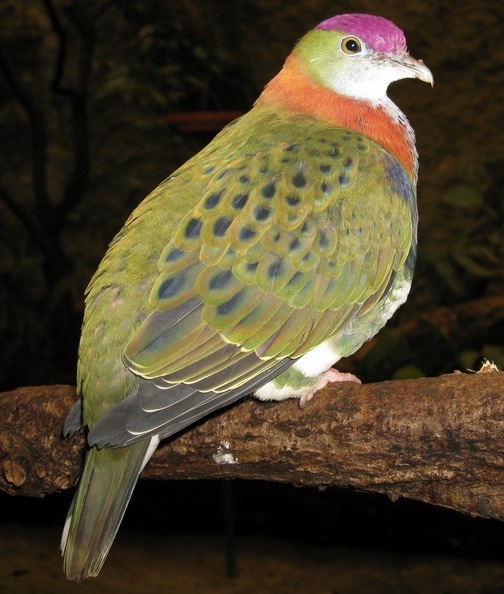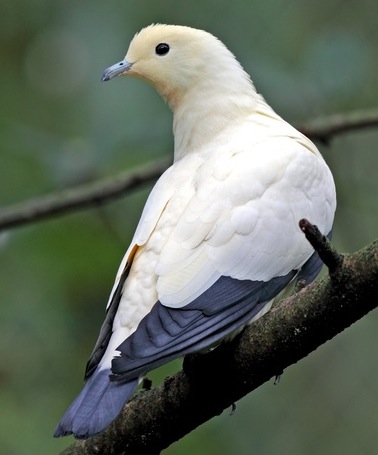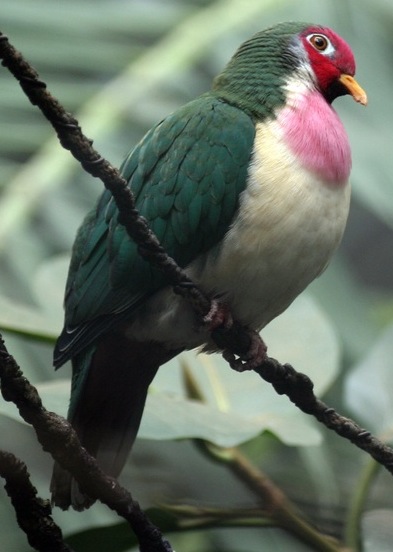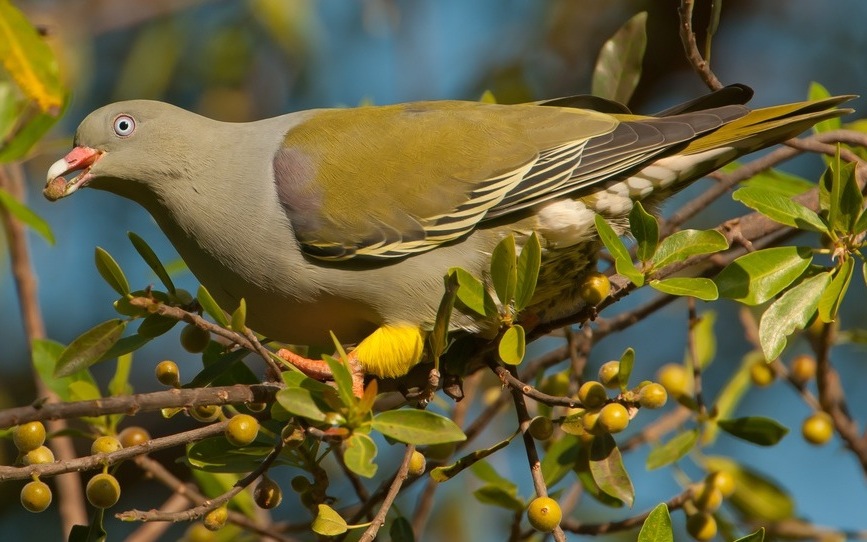Fruit Doves & Pigeons

The fruit doves (Ptilinopus species) such as the superb fruit dove (P. superbus) or the jambu (P. jambu) below left, are a very colourful group, occurring on the islands through the Pacific region down to Australia. The distribution of the fruit pigeons, which typically average about the size of a wood pigeon, is similar, while the so-called green pigeons (Treron species) represented in aviculture are found in both Asia and Africa.
Housing
Need to be housed in flights which can be easily cleaned, because of the significant amount of fruit featuring in their diet. A planted enclosure is recommended, with an aviary of this type offering a greater range of potential breeding sites as well. The nervous nature of these birds, especially in the case of the larger Ducula fruit pigeons, like the pied (D. bicolor) shown below, means that the roof of their quarters should be protected as far as possible to prevent foxes or cats climbing over here, and disturbing the birds.

Place the perches under cover at a higher level than elsewhere, to encourage the birds not to roost in the open in the flight. Pairs will nevertheless prove relatively hardy once acclimatised.
Feeding preferences
Fruit should make up a significant part of their diet. Dice large fruits such as apple, but these birds are generally able to swallow grapes and cherries whole, sometimes regurgitating the stones afterwards. Sprinkle the fruit with a softbill mix, or better still, mix soaked softbill pellets in with the fruit. This will help to ensure that the birds receive a more balanced diet, as they will rarely eat loose softbill food with much enthusiasm. Livefood is typically ignored, even when young are being reared. Green pigeons may eat some seed as well.
Breeding

Pairs nest on a typical loose platform made of twigs and other material such as moss. Offer several possible nesting sites to a pair breeding for the first time. They generally prefer somewhere relatively high up and secluded, but avoid putting a nesting platform just beneath the roof where the flight is covered with plastic sheeting, because the temperature beneath may become unbearably hot here in the summer.
Pairs may sometimes prefer to choose a nesting site in the shelter, especially if they go in here to be fed regularly. Beware that hens do not suffer from being badly persecuted by their mates during the courtship period. Both sexes incubate in turn, with cock birds tending to sit during the day.
Sociability
Pairs should be kept separately from each other, but can be accommodated with other non-aggressive softbills or seedeaters. However, their rather clumsy flight and nervous natures mean that they can create something of a disturbance, especially in a relatively small aviary.
Health watch
Newly-imported individuals can be rather heavily infested with tapeworms, causing weight loss. These can be treated successfully by dosing them directly with suitable deworming tablets. These need to be dropped down the back of the throat, and the bill should be held closed for a few moments, to encourage the bird to swallow the medication.

Good to start with: The African green pigeon (Treron calva), one of the more widely-distributed African species.
Clutch size: Two eggs.
Incubation and fledging periods: Both last approximately 13 days.
Enthusiast’s guide
Pigeons and Doves by David Gibbs, Eustace Barnes and John Cox. Published by Pica Press.
For more care information, see Pigeons and Doves: care and breeding by David Alderton, available as an ebook.